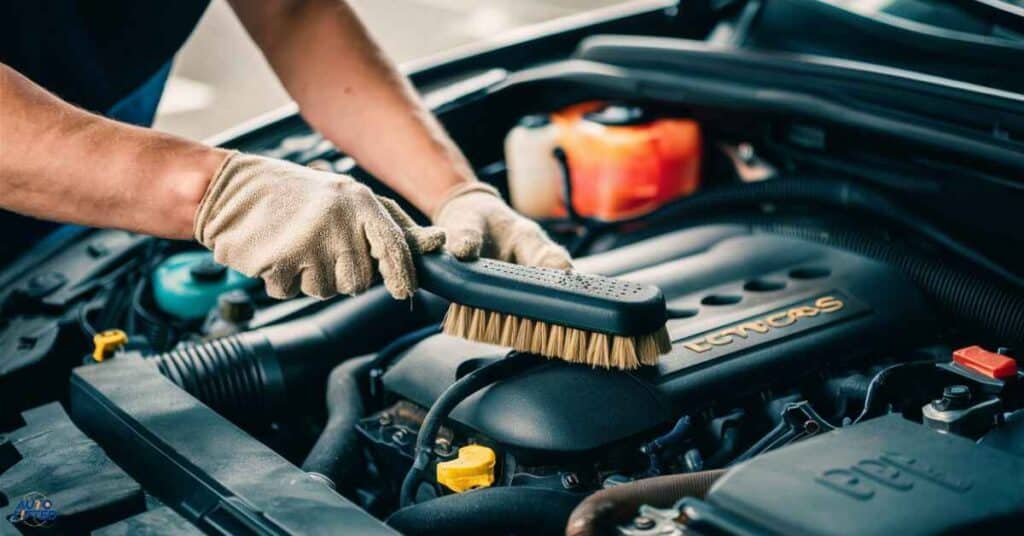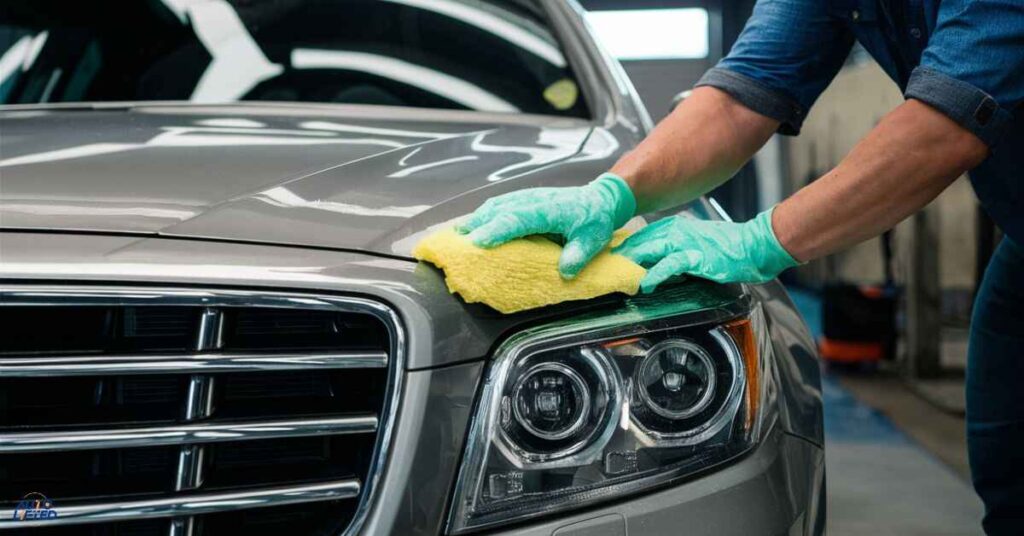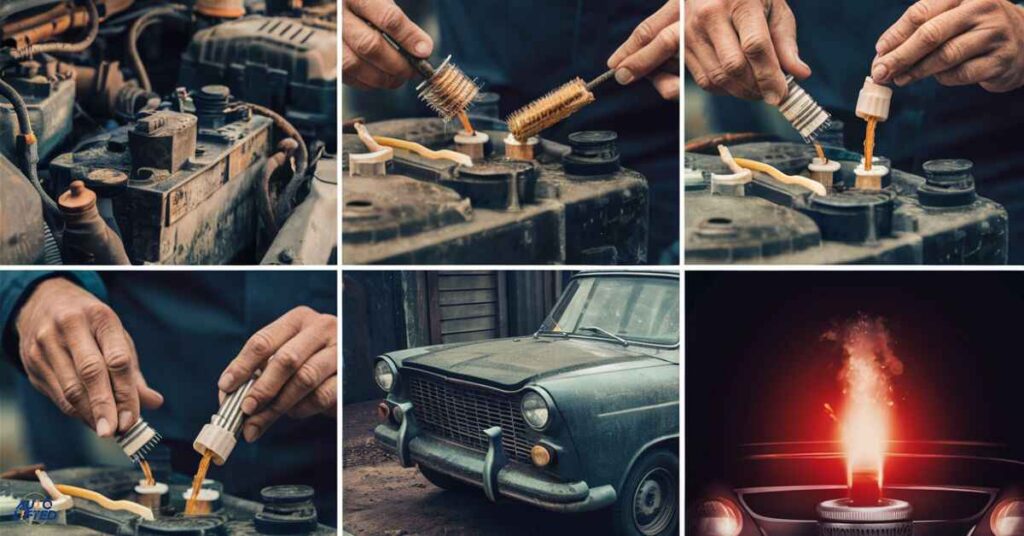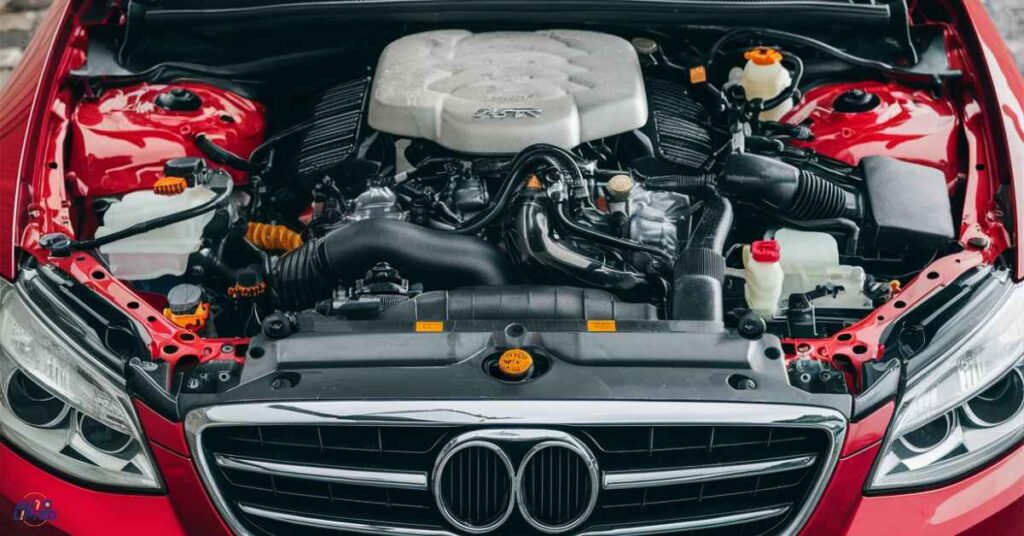Cleaning your car engine is essential for maintenance. A clean engine improves performance and extends its life. Start by cooling the engine. Remove loose dirt with a brush or vacuum. Cover electrical parts and disconnect the battery. Apply degreaser and let it sit.
Scrub thoroughly and rinse carefully. Dry with microfiber towels. Apply protectant and reconnect the battery. Regular cleaning keeps your engine running smoothly and helps spot potential issues early.
Let the Engine Cool Down

Before you begin cleaning your car engine, it is crucial to let the engine cool down completely. Working on a hot engine can be dangerous, posing risks of burns and accidental damage to engine components. Cooling down also prevents any cleaning products from evaporating too quickly, ensuring they work effectively. Typically, waiting at least 30 minutes after driving should be sufficient, but always check to ensure the engine is no longer hot to the touch before proceeding.
Read This Blog:
How Much Tip For Car Wash?
Importance of Letting the Engine Cool Down
Safety: Handling a hot engine can result in severe burns or injuries. Allowing the engine to cool down reduces the risk of accidents during the cleaning process.
Preventing Damage: Hot engine components can warp or crack if exposed to cold water suddenly. Cooling down the engine prevents thermal shock, which can damage vital parts.
Effective Cleaning: Cleaning products like degreasers work more efficiently on a cool engine. High temperatures can cause these products to evaporate too quickly, reducing their effectiveness.
Protecting Electrical Systems: Heat can make electrical components more vulnerable. Cooling the engine helps safeguard these parts from potential short circuits or damage during cleaning.
Ensuring Proper Inspection: A cool engine allows for a more thorough inspection of its components, helping you identify issues like leaks or wear without the interference of heat distortions.
Why You Should Let the Engine Cool Down Before Cleaning
Safety: Handling a hot engine can lead to serious burns and injuries. Allowing it to cool ensures a safer cleaning process.
Preventing Thermal Shock: Spraying cold water on a hot engine can cause thermal shock potentially cracking or warping engine components.
Enhanced Cleaning Efficiency: Cleaning products, such as degreasers, work better on a cool engine, as they don’t evaporate quickly and can effectively break down grime.
Electrical Protection: Hot engine components make electrical parts more susceptible to damage. Cooling down helps protect these parts from short circuits and other issues.
Accurate Inspections: A cool engine allows for a more precise inspection, helping you identify issues like leaks or worn parts without the distortions caused by heat.
Safety Tips: Cooling Down Your Engine
Wait After Driving: Allow at least 30 minutes after driving to let the engine cool down. This ensures it’s safe to touch and work on.
Check Temperature: Carefully touch the engine or hood to check if it has cooled sufficiently. If it’s still warm, give it more time to cool.
Open the Hood: Opening the hood can help dissipate heat faster by allowing air to circulate around the engine bay.
Avoid Water Contact: Do not spray water on a hot engine to cool it down. This can cause thermal shock and damage components.
Use a Fan: Placing a fan near the engine can help speed up the cooling process by increasing air circulation.
Park in the Shade: If possible, park the car in a shaded area to prevent the engine from heating up further while cooling down.
Plan Ahead: Schedule your cleaning for a time when the car has been idle for a while, such as in the morning or after it has been parked for several hours.
How Long Should You Let Your Engine Cool Down?
Risks of Cleaning a Hot Engine
Burns and Injuries: Hot engine parts can cause severe burns if touched, posing a significant risk to your safety.
Thermal Shock: Spraying cold water on a hot engine can cause thermal shock, leading to cracks or warping in engine components.
Reduced Cleaning Effectiveness: Cleaning products like degreasers may evaporate too quickly on a hot engine, diminishing their effectiveness in breaking down grime and grease.
Damage to Electrical Components: Heat makes electrical components more vulnerable to damage. Water exposure can lead to short circuits or permanent damage.
Harm to Plastic and Rubber Parts: High temperatures can make plastic and rubber parts brittle, increasing the risk of cracks or breakage during cleaning.
Corrosion Risk: Sudden temperature changes can accelerate corrosion in metal parts, leading to long-term damage and reduced engine lifespan.
Warping of Engine Parts: Rapid cooling from water can warp engine parts, affecting engine performance and potentially leading to costly repairs.
Preparing Your Engine for Cleaning: Cooling Down Steps
Turn Off the Engine: Ensure the engine is completely turned off to prevent accidents during cooling.
Wait After Driving: Allow the engine to cool for at least 30 minutes after driving to avoid thermal shock.
Open the Hood: Lift the hood to promote airflow and aid in the cooling process.
Check Temperature: Verify the engine’s temperature by touching it before proceeding.
Use a Fan: Employ a fan to accelerate cooling by increasing air circulation.
Shaded Parking: Park the car in a shaded area, if possible, to prevent additional heat buildup.
Avoid Water Contact: Do not spray water on the hot engine to prevent thermal shock and damage.
Prioritize Safety: Always prioritize safety to prevent accidents or injuries during the cooling process.
Best Practices for Engine Cooling Before Washing
Allow Ample Time: Ensure the engine has enough time to cool down completely before washing to prevent thermal shock.
Turn Off the Engine: Always switch off the engine before beginning the cooling and washing process for safety.
Check Temperature: Confirm the engine has cooled down to a safe temperature by touching it cautiously.
Open the Hood: Lift the hood to promote airflow and aid in the cooling process.
Utilize a Fan: Use a fan, if available, to accelerate cooling by increasing air circulation around the engine bay.
Avoid Direct Sunlight: Park the vehicle in a shaded area to prevent additional heat exposure and facilitate quicker cooling.
Practice Patience: Allow sufficient time for the engine to cool thoroughly before proceeding with washing.
Prioritize Safety: Always prioritize safety to avoid accidents or injuries during the engine cooling and washing process.
Also Read This Blog:
What Can Cause A Car To Misfire
Remove Dry Debris, Dirt, and Loose Dust With a Brush or Vacuum

To start cleaning your car engine, use a brush to remove any dry debris, dirt, and loose dust. This step is important because it prevents these particles from mixing with water and potentially causing damage during the cleaning process. A brush with soft bristles is ideal to avoid scratching or damaging sensitive engine components. Carefully sweep away the debris from all accessible areas of the engine bay, including nooks and crannies where dirt may accumulate. Be thorough but gentle to ensure effective removal without causing any harm to the engine.
Unhook the Car Battery Terminal and Protect Electrical Components
Before cleaning your car engine, it’s essential to unhook the car battery terminal to prevent any electrical mishaps. This step ensures your safety and protects the electronic components from potential damage during the cleaning process.
Additionally, cover the electrical components with plastic coverings or bags to shield them from water and cleaning solutions. Taking these precautions minimizes the risk of short circuits or corrosion, preserving the integrity of your vehicle’s electrical system and avoiding costly repairs.
Apply the Engine Degreaser
Next, apply an engine degreaser to effectively remove grease and grime buildup from your car engine. Ensure even coverage across all areas that require cleaning, but avoid saturating sensitive components. The degreaser works by breaking down stubborn dirt, making it easier to remove during the scrubbing process.
Choose a high-quality degreaser suitable for automotive use and follow the manufacturer’s instructions for best results. Allow the degreaser to penetrate and loosen the grime for the recommended amount of time before proceeding to the next step.
Let the Degreaser Sit
After applying the engine degreaser, allow it to sit for the specified duration recommended by the product instructions. This waiting period is crucial as it gives the degreaser sufficient time to penetrate and break down the accumulated grease and grime effectively.
Avoid rushing this step to ensure optimal cleaning results. While the degreaser sits, it continues to work on loosening the dirt, making it easier to remove during the subsequent cleaning process. Patience during this stage ensures thorough cleaning and helps achieve the best possible outcome for your car engine.
Scrub the Engine with a Detailing Brush Until Clean

Now, it’s time to scrub the engine thoroughly using a detailing brush until it’s clean. Focus on areas with heavy buildup of grease and grime, using firm but gentle strokes to dislodge the dirt. Pay close attention to hard-to-reach areas and crevices where dirt may accumulate.
The detailing brush’s bristles help agitate the degreaser, further breaking down stubborn residues. Work systematically, starting from one end of the engine bay and progressing methodically to ensure complete coverage. Regularly rinse the brush in clean water to prevent transferring dirt back onto the engine.
Rinse With a Pressure Washer or Steamer, and Wipe Dry With Microfiber Towels
After scrubbing the engine, rinse it thoroughly with a pressure washer or steamer to remove the loosened dirt and degreaser residue. The high-pressure water helps flush away the grime effectively, leaving behind a clean surface. Be cautious around sensitive components and electrical parts to avoid damage.
Once rinsed, wipe the engine dry using microfiber towels to prevent water spots and promote faster drying. Pay attention to detail, ensuring all areas are adequately dried to prevent corrosion and maintain a pristine appearance.
Apply Engine Protectant
After cleaning and drying the engine, apply an engine protectant to safeguard it against future dirt and grime buildup. Engine protectants help maintain the cleanliness of the engine bay and provide an additional layer of defense against environmental elements. Apply the protectant evenly to all accessible surfaces using a clean cloth or applicator pad. Ensure thorough coverage, but avoid applying excessive amounts to prevent drips or streaks. Regular application of engine protectant prolongs the cleanliness of your engine and enhances its overall appearance.
Reattach the Car Battery Terminal and Start the Car

Finally, reattach the car battery terminal to its proper position once the engine cleaning process is complete. Ensure that the terminal is securely connected to prevent any electrical issues. After reconnecting the battery, start the car to confirm that everything is functioning as it should.
This step allows you to verify that there are no electrical problems resulting from the cleaning process. If the car starts up smoothly and operates normally, you can rest assured that the engine cleaning was successful and your vehicle is ready to hit the road again.
Benefits of Cleaning the Car Engine
Improved Performance: A clean engine operates more efficiently, leading to better fuel economy and smoother running.
Increased Longevity: Regular cleaning helps prevent dirt and grime buildup, reducing wear and tear on engine components and extending their lifespan.
Easier Maintenance: A clean engine bay makes it easier to spot leaks, worn belts, or other issues early on, allowing for prompt maintenance and preventing potential breakdowns.
Enhanced Safety: Removing grease and debris reduces the risk of fire hazards and electrical malfunctions, ensuring a safer driving experience.
Enhanced Safety: Removing grease and debris reduces the risk of fire hazards and electrical malfunctions, ensuring a safer driving experience.
Preserved Resale Value: A well-maintained engine bay enhances the overall appearance of your vehicle, potentially increasing its resale value when it comes time to sell or trade-in.
Environmental Benefits: Keeping your engine clean reduces harmful emissions and minimizes environmental impact, contributing to cleaner air and a healthier environment overall.A well-maintained engine bay enhances the overall appearance of your vehicle, potentially increasing its resale value when it comes time to sell or trade-in.
Environmental Benefits: Keeping your engine clean reduces harmful emissions and minimizes environmental impact, contributing to cleaner air and a healthier environment overall.
How to Keep Your Car’s Engine Bay Clean
Regular Cleaning: Schedule routine engine bay cleanings as part of your car maintenance routine. Aim for at least every six months or more frequently if you live in a dusty or dirty environment.
Park in a Covered Area: Whenever possible, park your car in a garage or covered parking area to shield the engine bay from dirt, debris, and the elements.
Use Protective Coverings: If covered parking isn’t available, use a car cover to protect the engine bay when parked outdoors for extended periods.
Avoid Driving Through Puddles: Steer clear of deep puddles or flooded areas to prevent water from splashing into the engine bay, potentially causing damage or corrosion.
Inspect Regularly: Periodically inspect the engine bay for signs of leaks, dirt buildup, or damage. Address any issues promptly to prevent them from worsening.
Clean Spills Immediately: If you notice any spills or leaks, clean them up promptly to prevent them from attracting dirt and grime, which can lead to buildup over time.
Use Engine Bay Dressings: Apply a quality engine bay dressing or protectant after cleaning to help repel dirt and maintain a clean appearance. Be sure to follow the product instructions for best results.
Avoid Overuse of Water: When cleaning the engine bay, be cautious not to use excessive amounts of water, especially around electrical components. Use a gentle stream and avoid high-pressure washers.
Park in Garage or Use Protective Coverings
To maintain a clean engine bay, prioritize parking your vehicle in a garage whenever possible. Garages provide protection from outdoor elements such as dirt, debris, and weather conditions, helping to keep the engine bay clean and free from buildup.
If a garage is not available, consider using protective coverings such as car covers. These covers shield the engine bay from dust, pollen, bird droppings, and other contaminants, preserving its cleanliness between cleanings.
By parking in a garage or using protective coverings, you can extend the intervals between engine bay cleanings and maintain your vehicle’s overall appearance and performance.
Wash Your Car Regularly

Regular car washing is essential for maintaining not just the exterior but also the engine bay. Make it a habit to wash your car regularly, including the engine bay, to prevent dirt and grime buildup.
Use a gentle car wash soap and water to clean the exterior, ensuring to also rinse the engine bay area thoroughly. Pay attention to detail, cleaning hard-to-reach areas and removing any visible debris. Regular washing not only keeps your car looking great but also helps prevent corrosion and ensures optimal engine performance.
Frequently Asked Question
Is it OK to wash the engine of a car?
Yes, it is safe to wash the engine if you follow proper precautions, such as protecting electrical components.
Is it safe to spray your engine with water?
Yes, but use a gentle stream and avoid high pressure, especially around sensitive areas.
What can I use to clean my car engine?
Use an engine degreaser, detailing brush, and microfiber towels for effective cleaning.
Can you wash your car with the engine running?
No, always turn off the engine and let it cool down before washing to avoid any risks.
What are the risks of engine wash?
Improper washing can cause electrical damage, corrosion, and short circuits.
What to avoid when cleaning the engine?
Avoid using high-pressure water and soaking electrical components directly.
Conclusion
Cleaning your car engine is a crucial aspect of vehicle maintenance that enhances performance, longevity, and safety. Begin by allowing the engine to cool down to avoid burns and damage.
Remove loose dirt and debris with a brush or vacuum, then unhook the battery terminal and cover electrical components to prevent water damage. Apply a quality engine degreaser and let it sit to break down grease and grime.
Scrub the engine thoroughly with a detailing brush, rinse carefully with a gentle stream of water, and dry with microfiber towels. Finally, apply an engine protectant to prevent future buildup and reconnect the battery.
Regularly cleaning your engine bay and taking precautions like parking in a garage or using protective coverings will help maintain its cleanliness.
By following these steps, you ensure your engine remains in optimal condition, contributing to the vehicle’s overall performance and longevity while minimizing potential risks.







